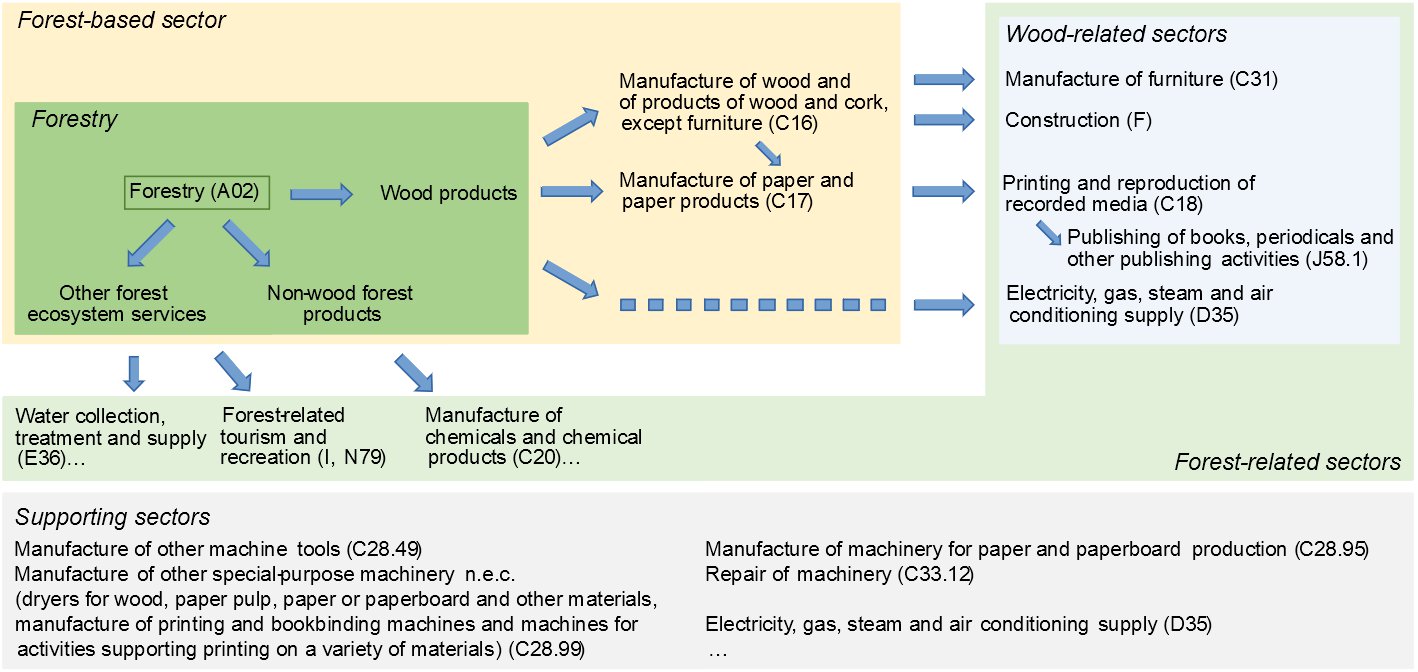Forests produce one third of the biomass in Europe in 2013 (Camia et al. 2018) out of which two third is felled. This reservoir of biomass, together with improvements along the forest-based value-chains, constitutes a large potential to support the development of the bioeconomy. The forest sector, which includes “Forestry and logging”, the “manufacture of wood and of products of wood and cork”, and the “manufacture of paper and paper products” employs more than 2.1 million workers for a total turnover of 344 billion euros (in 2013, Ronzon et M’Barek 2018). This composite sector is then main supplier of forest goods and services to the economy and allow for a wider of economic activities in Europe.
Our research objective is to detail the relationship between the forest sector and the entire economy and to estimate how forests and all related sectors can contribute to a sustainable and circular bioeconomy. In a first step, we expand the forest sector to the main sectors using wood as a major input in their processing, adding in particular the manufacture of wooden furniture, the paper printing and publishing activities, the production of energy from wood and the construction with wood (carpentry, wooden flooring, wooden houses…).

In a further extension, we are accounting for the valorisation of forest ecosystem services. Socio-economic indicators focus on jobs, productivity by worker and unit of wood processed, turnover and value added along the value chains.
We use two different methodologies to estimate the socio-economic indicators. The first one relies on estimates of employment from the labour force survey and, for sectors that are partly related to forest, on estimates derived from the national accounts (use tables in particular) and expert assumptions. The second methodology consists in developing social accounting matrices that detail the forest sector, wood-based products and ecosystem services. From these matrices, multipliers such as employment and value added per unit of wood entering the economy can be derived.
Altogether, about 4.4 million jobs were related to forest and wood in the EU-28 in 2015, half of which in the forest sector. Specialization patterns can be observed between countries with:
- the entire value chain, from primary production to the final goods and services such as Finland, Slovakia and Sweden,
- the entire value chain, but dominated by the first transformation and production of final goods such as Belgium, Austria, Italy, France…
- mainly primary production and first transformation such as Latvia, Croatia and Czech Republic,
- an emphasis on final products such as the Netherlands, Ireland, Germany, Denmark and Malta.
This helps evaluate the possibilities to develop the forest-related sectors in the different countries in order to increase the value added and employment.
References
Camia, Andrea, Nicolas Robert, Klas Jonsson, Roberto Pilli, Sara Garcia Condado, Raul Lopez Lozano, Marijn Van Der Velde, et al. 2018. ‘Biomass Production, Supply, Uses and Flows in the European Union: First Results from an Integrated Assessment’. EUR - Scientific and Technical Research Reports. Publications Office of the European Union. JRC109869. https://doi.org/10.2760/181536.
Ronzon, Tévécia, and Robert M’Barek. 2018. ‘Socioeconomic Indicators to Monitor the EU’s Bioeconomy in Transition’. Sustainability 10 (6): 1745. https://doi.org/10.3390/su10061745.

